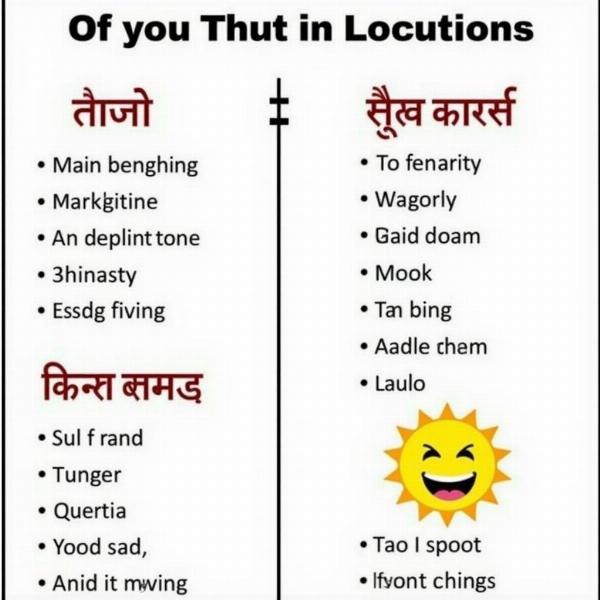Locution meaning in Hindi often revolves around the concept of “मुहावरा” (muhaavara) or “कहावत” (kahaavat). Understanding locutions is essential for grasping the nuances of the Hindi language, as they add depth and richness to communication. Whether you’re translating documents, interpreting conversations, or simply trying to improve your Hindi comprehension, a strong grasp of locutions is crucial.
Understanding the Nuances of “Locution” in Hindi
The word “locution” itself doesn’t have a direct, single-word equivalent in Hindi. It refers to a particular style of speech or expression, encompassing phrases, idioms, and even specific word choices. Therefore, the meaning in Hindi depends on the specific context. While “मुहावरा” (muhaavara – idiom) and “कहावत” (kahaavat – proverb) are the closest equivalents, they don’t capture the full scope of “locution.” Sometimes, “शब्द-प्रयोग” (shabd-prayog – word usage) or “भाषा-प्रयोग” (bhasha-prayog – language usage) might be more appropriate.
Why is Understanding Locution Important?
Locutions are integral to any language, including Hindi. They convey cultural nuances, add color to expression, and often communicate a deeper meaning than literal words. For translators, understanding locutions is paramount for accurate and culturally sensitive translations. For learners, grasping locutions helps them achieve fluency and appreciate the richness of Hindi literature and conversation.
Common Hindi Locutions and their Meanings
Here are some common Hindi locutions and their meanings:
- हाथी के दाँत खाने के और दिखाने के और (Hathi ke daant khane ke aur, dikhane ke aur): This translates to “An elephant has different sets of teeth for eating and showing.” It implies that someone says one thing and does another.
- ऊँट के मुँह में जीरा (Oont ke munh mein jeera): “A cumin seed in a camel’s mouth.” This signifies a situation where a small amount is insignificant compared to the need.
- अँगूठा दिखाना (Angootha dikhana): “To show the thumb.” This signifies refusal or disapproval.
 Common Hindi Locutions Examples
Common Hindi Locutions Examples
Locution in Different Contexts: From Legal to Literary
The interpretation of “locution” varies across different fields. In legal contexts, it can refer to the specific wording of a law or contract. In literature, it refers to the author’s style and choice of words. Even within everyday conversations, the specific locution used can significantly impact the meaning conveyed.
What does Locution Mean in Legal Hindi?
In legal Hindi, precise language is crucial. “वाक्य रचना” (vakya rachna – sentence construction) and “शब्दावली” (shabdavali – vocabulary) become particularly important. functional grammar meaning in hindi plays a key role here. Accurate translation of legal locutions is essential to avoid misinterpretations and ensure legal validity.
Locution in Hindi Literature
In Hindi literature, locutions add depth and artistry. Authors use “अलंकार” (alankar – figures of speech) and “रस” (ras – aesthetic flavor) to enhance their writing. Understanding these literary locutions is vital for appreciating the beauty and complexity of Hindi literature. inter house competition meaning in hindi often encourages exploration of these nuances.
Locution and Translation: Challenges and Best Practices
Translating locutions accurately can be challenging. Direct translation often fails to capture the intended meaning. Translators need to understand the cultural context and find equivalent expressions in the target language. circumlocutory meaning in hindi can sometimes be relevant in understanding the nuances of translation.
Conclusion
Understanding “locution meaning in Hindi” is crucial for anyone seeking to master the language. It goes beyond simple vocabulary and delves into the nuances of expression, cultural context, and the art of communication. Whether you’re a student, translator, or simply interested in Hindi language and culture, grasping the concept of locutions will enrich your understanding and appreciation of this vibrant language. inter school meaning in hindi can further benefit from exploring these aspects.
FAQ
-
What is the simplest way to understand the meaning of “locution” in Hindi? Think of it as a way of speaking, a particular expression, or a phrase that carries a specific meaning.
-
Why are locutions important in Hindi? They add depth to communication, reflect cultural nuances, and make the language more expressive.
-
How can I learn more about Hindi locutions? Reading Hindi literature, watching Hindi movies, and conversing with native speakers are excellent ways to learn.
-
Are there any resources for translating Hindi locutions? Yes, dictionaries, online resources, and professional translators can help.
-
What is the difference between “muhaavara” and “kahaavat”? “Muhaavara” is an idiom, while “kahaavat” is a proverb.
-
Is it necessary to understand locutions for basic Hindi communication? While not strictly necessary for basic communication, understanding locutions significantly enhances fluency and comprehension.
-
How does “locution” relate to grammar? Locutions often involve specific grammatical structures and word choices. couple friendly meaning in hindi may offer another example of nuanced language use.
Meaning-Hindi.in is your trusted partner for all your Hindi translation needs. We offer expert translation services across various domains, from business and legal documents to technical manuals and website localization. Our team of experienced translators ensures accuracy, cultural sensitivity, and timely delivery. Whether you need document translation, interpretation services, or language learning resources, Meaning-Hindi.in has you covered. Contact us today at [email protected] or +91 11-4502-7584.